Improved Daytime Cloud Detection Algorithm in FY-4A’s Advanced Geostationary Radiation Imager
Abstract
1. Introduction
2. Materials and Methods
2.1. Datasets
2.2. Methodology
2.2.1. Adjusted Fisher Discriminant Analysis (AFDA)
2.2.2. Spectral Spatial Variability (SSV)
3. Algorithm Construction
3.1. Multiple Detector Assessment
3.2. Modification of MODIS Cloud Mask Rectification Algorithm
- (1)
- Select the cloudy pixels in MODIS cloud mask, and judge whether the cloud top height (CTH) is lower than 5 km and the reflection of 1.38 μm is smaller than 0.04. Go to the next step if both conditions are satisfied. Otherwise, stop verification and regard it as a true cloud.
- (2)
- Plug the reflection and BT of the bands shown in Table 1 into the updated formula and calculate the y-value. If y is greater than 0, then regard this pixel as a true cloud; otherwise, treat it as a misjudged cloud and eliminate it.
3.3. Sample Selection
3.4. Adjusted Fisher Discrimination Formula Construction
3.5. Spectral Spatial Variability Algorithm Construction
4. Performance Assessment
5. Conclusions
Author Contributions
Funding
Institutional Review Board Statement
Informed Consent Statement
Data Availability Statement
Conflicts of Interest
References
- Mao, F.; Duan, M.; Min, Q.; Gong, W.; Pan, Z.; Liu, G. Investigating the impact of haze on MODIS cloud detection. J. Geophys. Res. Atmos. 2015, 120, 12–237. [Google Scholar] [CrossRef]
- Tan, S.C.; Zhang, X.; Wang, H.; Chen, B.; Shi, G.Y.; Shi, C. Comparisons of cloud detection among four satellite sensors on severe haze days in eastern China. Atmos. Ocean. Sci. Lett. 2018, 11, 86–93. [Google Scholar] [CrossRef]
- Frey, R.A.; Ackerman, S.A.; Liu, Y.; Strabala, K.I.; Zhang, H.; Key, J.R.; Wang, X. Cloud detection with MODIS. Part I: Improvements in the MODIS cloud mask for collection 5. J. Atmos. Ocean. Technol. 2008, 25, 1057–1072. [Google Scholar] [CrossRef]
- Ackerman, S.A.; Holz, R.E.; Frey, R.; Eloranta, E.W.; Maddux, B.C.; McGill, M. Cloud detection with MODIS. Part II: Validation. J. Atmos. Ocean. Technol. 2008, 25, 1073–1086. [Google Scholar] [CrossRef]
- Ghosh, R.R.; Ali, M.S.; Hena, A.; Rahman, H. A simple cloud detection algorithm using NOAA-AVHRR satellite data. Int. J. Sci. Eng. Res. 2012, 3, 6. [Google Scholar]
- Meerkötter, R.; König, C.; Bissolli, P.; Gesell, G.; Mannstein, H. A 14-year European Cloud Climatology from NOAA/AVHRR data in comparison to surface observations. Geophys. Res. Lett. 2004, 31, 15. [Google Scholar] [CrossRef]
- Zhang, X.; Tan, S.C.; Shi, G.Y.; Wang, H. Improvement of MODIS cloud mask over severe polluted eastern China. Sci. Total Environ. 2019, 654, 345–355. [Google Scholar] [CrossRef] [PubMed]
- Zhang, X.; Wang, H.; Che, H.Z.; Tan, S.C.; Shi, G.Y.; Yao, X.P. The impact of aerosol on MODIS cloud detection and property retrieval in seriously polluted East China. Sci. Total Environ. 2020, 711, 134634. [Google Scholar] [CrossRef]
- Li, Z.; Shen, H.; Wei, Y.; Cheng, Q.; Yuan, Q. Cloud detection by fusing multi-scale convolutional features. ISPRS Ann. 2018, 4, 149–152. [Google Scholar] [CrossRef]
- He, Q.; Sun, X.; Yan, Z.; Fu, K. DABNet: Deformable contextual and boundary-weighted network for cloud detection in remote sensing images. IEEE Trans. Geosci. Remote Sens. 2021, 60, 1–16. [Google Scholar] [CrossRef]
- Ghasemian, N.; Akhoondzadeh, M. Introducing two Random Forest based methods for cloud detection in remote sensing images. Adv. Space Res. 2018, 62, 288–303. [Google Scholar] [CrossRef]
- Fu, H.; Shen, Y.; Liu, J.; He, G.; Chen, J.; Liu, P.; Qian, J.; Li, J. Cloud detection for FY meteorology satellite based on ensemble thresholds and random forests approach. Remote Sens. 2018, 11, 44. [Google Scholar] [CrossRef]
- Xu, L.; Fang, S.; Niu, R.; Li, J. Cloud detection based on decision tree over tibetan plateau with modis data. ISPRS Arch. 2012, 39, 535–538. [Google Scholar] [CrossRef]
- Zhang, Q.; Yu, Y.; Zhang, W.; Luo, T.; Wang, X. Cloud detection from fy-4a’s geostationary interferometric infrared sounder using machine learning approaches. Remote Sens. 2019, 11, 3035. [Google Scholar] [CrossRef]
- Tan, K.; Zhang, Y.; Tong, X. Cloud extraction from Chinese high resolution satellite imagery by probabilistic latent semantic analysis and object-based machine learning. Remote Sens. 2016, 8, 963. [Google Scholar] [CrossRef]
- Ishida, H.; Oishi, Y.; Morita, K.; Moriwaki, K.; Nakajima, T.Y. Development of a support vector machine based cloud detection method for modis with the adjustability to various conditions. Remote Sens. Environ. 2017, 205, 390–407. [Google Scholar] [CrossRef]
- Shao, Z.; Deng, J.; Wang, L.; Fan, Y.; Sumari, N.S.; Cheng, Q. Fuzzy autoencode based cloud detection for remote sensing imagery. Remote Sens. 2017, 9, 311. [Google Scholar] [CrossRef]
- Zhang, Y.; Guindon, B.; Cihlar, J. An image transform to characterize and compensate for spatial variations in thin cloud contamination of Landsat images. Remote Sens. Environ. 2002, 82, 173–187. [Google Scholar] [CrossRef]
- Chen, S.; Chen, X.; Chen, J.; Jia, P.; Cao, X.; Liu, C. An iterative haze optimized transformation for automatic cloud/haze detection of Landsat imagery. IEEE Trans. Geosci. Remote Sens. 2015, 54, 2682–2694. [Google Scholar] [CrossRef]
- Xiong, Q.; Wang, Y.; Liu, D.; Ye, S.; Du, Z.; Liu, W.; Huang, J.; Su, W.; Zhu, D.; Yao, X.; et al. A cloud detection approach based on hybrid multispectral features with dynamic thresholds for GF-1 remote sensing images. Remote Sens. 2020, 12, 450. [Google Scholar] [CrossRef]
- Huang, C.; Thomas, N.; Goward, S.N.; Masek, J.G.; Zhu, Z.; Townshend, J.R.; Vogelmann, J.E. Automated masking of cloud and cloud shadow for forest change analysis using Landsat images. Int. J. Remote Sens. 2010, 31, 5449–5464. [Google Scholar] [CrossRef]
- Irish, R.R.; Barker, J.L.; Goward, S.N.; Arvidson, T. Characterization of the Landsat-7 ETM+ automated cloud-cover assessment (ACCA) algorithm. Photogramm. Eng. Remote Sens. 2006, 72, 1179–1188. [Google Scholar] [CrossRef]
- Scaramuzza, P.L.; Bouchard, M.A.; Dwyer, J.L. Development of the Landsat data continuity mission cloud-cover assessment algorithms. IEEE Trans. Geosci. Remote Sens. 2011, 50, 1140–1154. [Google Scholar] [CrossRef]
- Zortea, M.; Salberg, A.B.; Trier, Ø.D. Object-based cloud and cloud shadow detection in landsat images for tropical forest monitoring. In Proceedings of the 4th GEOBIA, Rio de Janeiro, Brazil, 7–9 May 2012; pp. 326–331. [Google Scholar]
- Zhu, X.; Helmer, E.H. An automatic method for screening clouds and cloud shadows in optical satellite image time series in cloudy regions. Remote Sens. Environ. 2018, 214, 135–153. [Google Scholar] [CrossRef]
- Surya, S.R.; Simon, P. Automatic Cloud Detection Using Spectral Rationing and Fuzzy Clustering. In Proceedings of the 2013 2nd International Conference on Advanced Computing, Networking and Security, Mangalore, India, 15–17 December 2013; pp. 90–95. [Google Scholar]
- Bo, P.; Su, F.Z.; Meng, Y.S. A cloud and cloud shadow detection method based on fuzzy c-means algorithm. IEEE J. Sel. Top. Appl. Earth Observ. Remote Sens. 2020, 13, 1714–1727. [Google Scholar] [CrossRef]
- Ma, N.; Sun, L.; Zhou, C.; He, Y. Cloud detection algorithm for multi-satellite remote sensing imagery based on a spectral library and 1D convolutional neural network. Remote Sens. 2021, 13, 3319. [Google Scholar] [CrossRef]
- Yang, J.; Zhang, Z.; Wei, C.; Lu, F.; Guo, Q. Introducing the new generation of Chinese geostationary weather satellites, Fengyun-4. Bull. Am. Meteorol. Soc. 2017, 98, 1637–1658. [Google Scholar] [CrossRef]
- Lu, F.; Zhang, X.; Chen, B.; Liu, H.; Wu, R.; Han, Q.; Feng, X.; Li, J.; Zhan, Z. FY-4 geostationary meteorological satellite imaging characteristic and its application prospects. J. Mar. Meteorol. 2017, 37, 1–12. [Google Scholar]
- Zhang, P.; Zhu, L.; Tang, S.; Gao, L.; Chen, L.; Zheng, W.; Han, X.; Chen, J.; Shao, J. General comparison of FY-4A/AGRI with other GEO/LEO instruments and its potential and challenges in non-meteorological applications. Front. Earth Sci. 2019, 6, 224. [Google Scholar] [CrossRef]
- Martins, J.V.; Tanré, D.; Remer, L.; Kaufman, Y.; Mattoo, S.; Levy, R. MODIS cloud screening for remote sensing of aerosols over oceans using spatial variability. Geophys. Res. Lett. 2002, 29, MOD4-1. [Google Scholar] [CrossRef]
- Chen, B.Y.; Qiong, W.U.; Feng, X.; Guo, Q.; Wei, C.Y. On-orbit test to FY-4A AGRI and generating RBG imagine. J. Infrared Millim. Waves 2018, 37, 411–415. [Google Scholar]
- Strabala, K.I. MODIS Cloud Mask User’s Guide; University of Wisconsin—Madison: Madison, WI, USA, 2005. [Google Scholar]
- Winker, D.M.; Hostetler, C.; Vaughan, M.; Omar, A. CALIOP Algorithm Theoretical Basis Document, Part 1: CALIOP Instrument, and Algorithms Overview, Release. J. Atmos. Ocean. Technol. 2006, 26, 2310–2323. [Google Scholar] [CrossRef]
- Winker, D.M.; Vaughan, M.A.; Omar, A.; Hu, Y.; Powell, K.A.; Liu, Z.; Hunt, W.H.; Young, S.A. Overview of the CALIPSO Mission and CALIOP Data Processing Algorithms. J. Atmos. Ocean. Technol. 2009, 26, 2310–2323. [Google Scholar] [CrossRef]




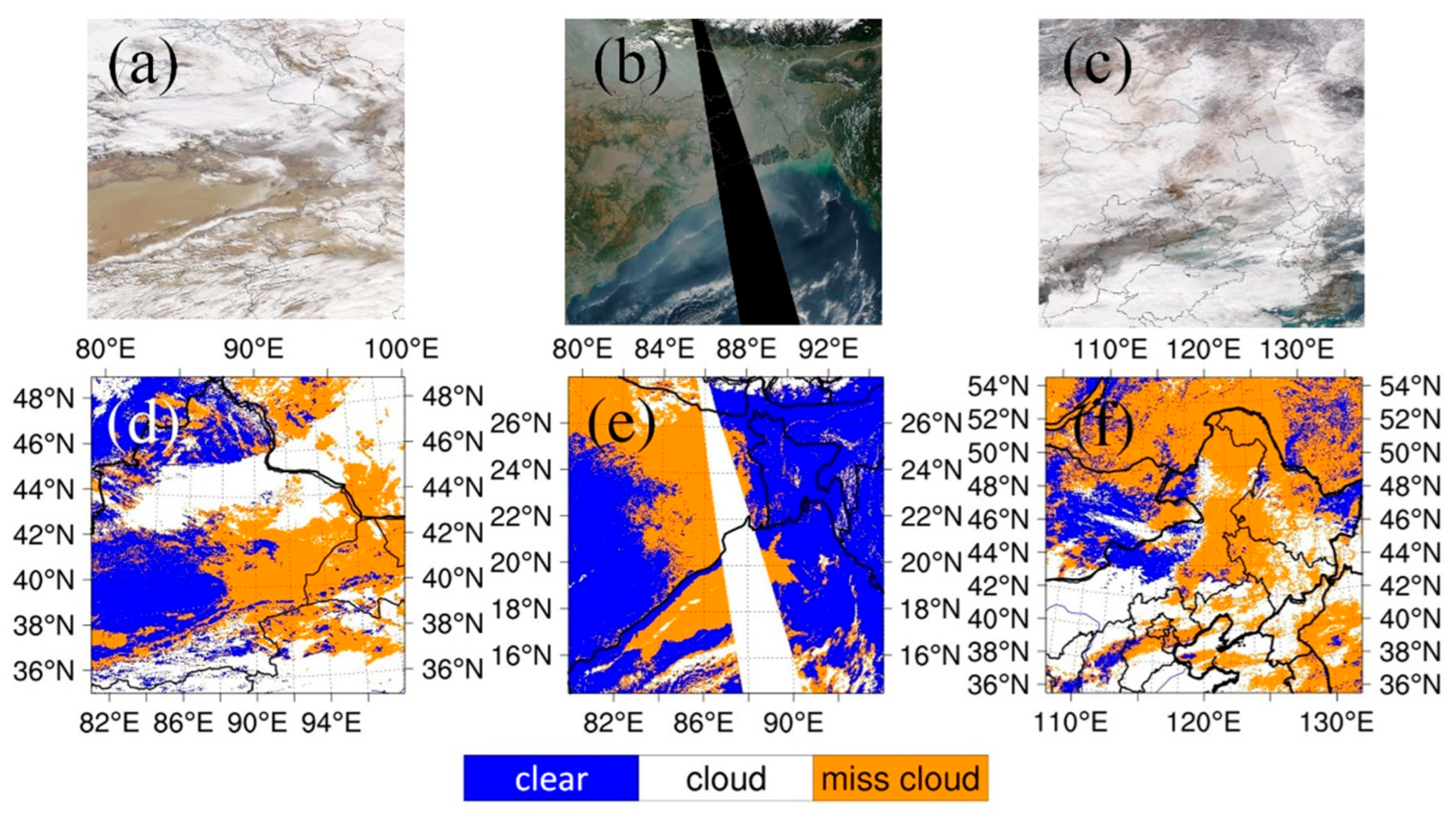
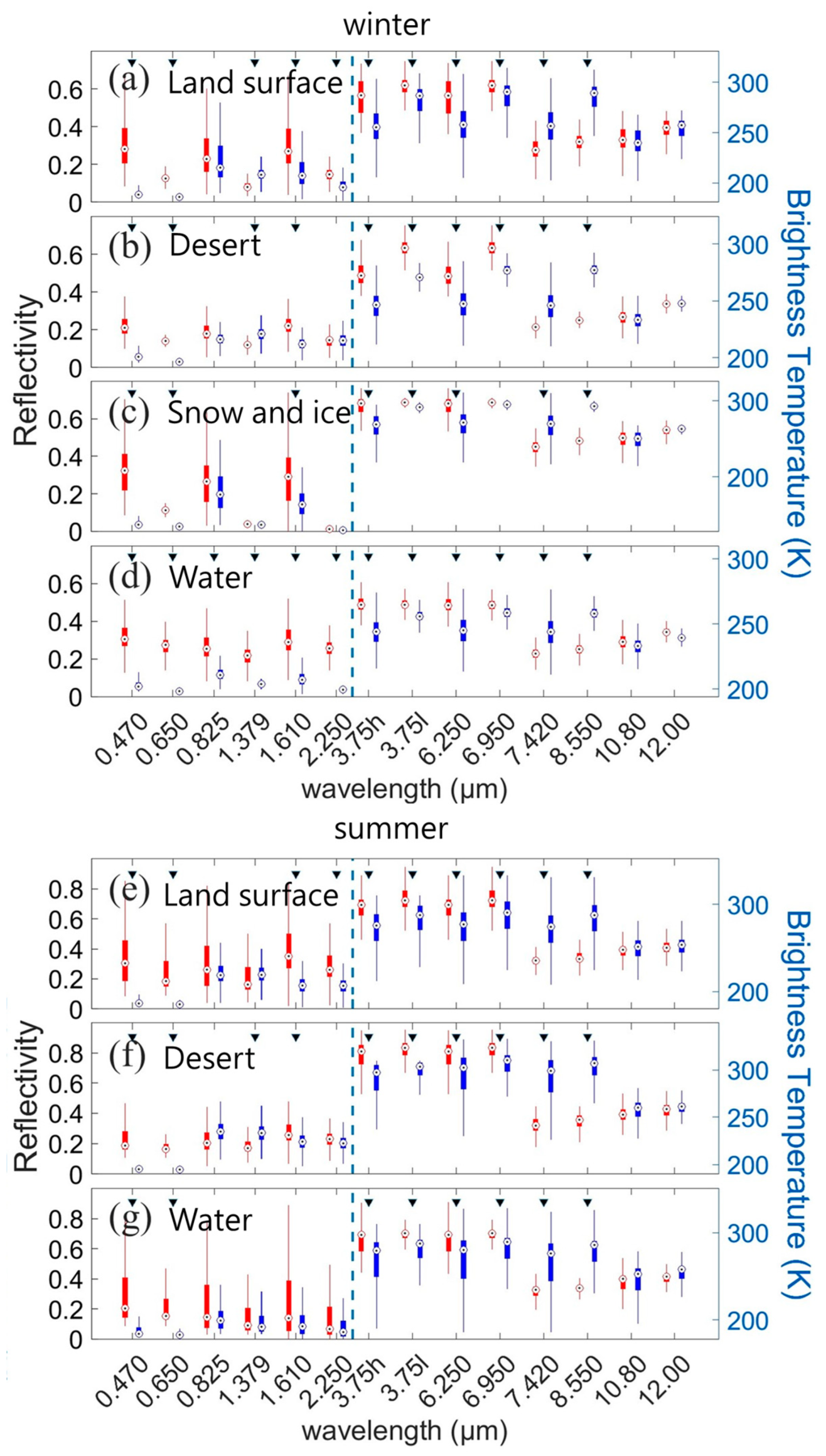
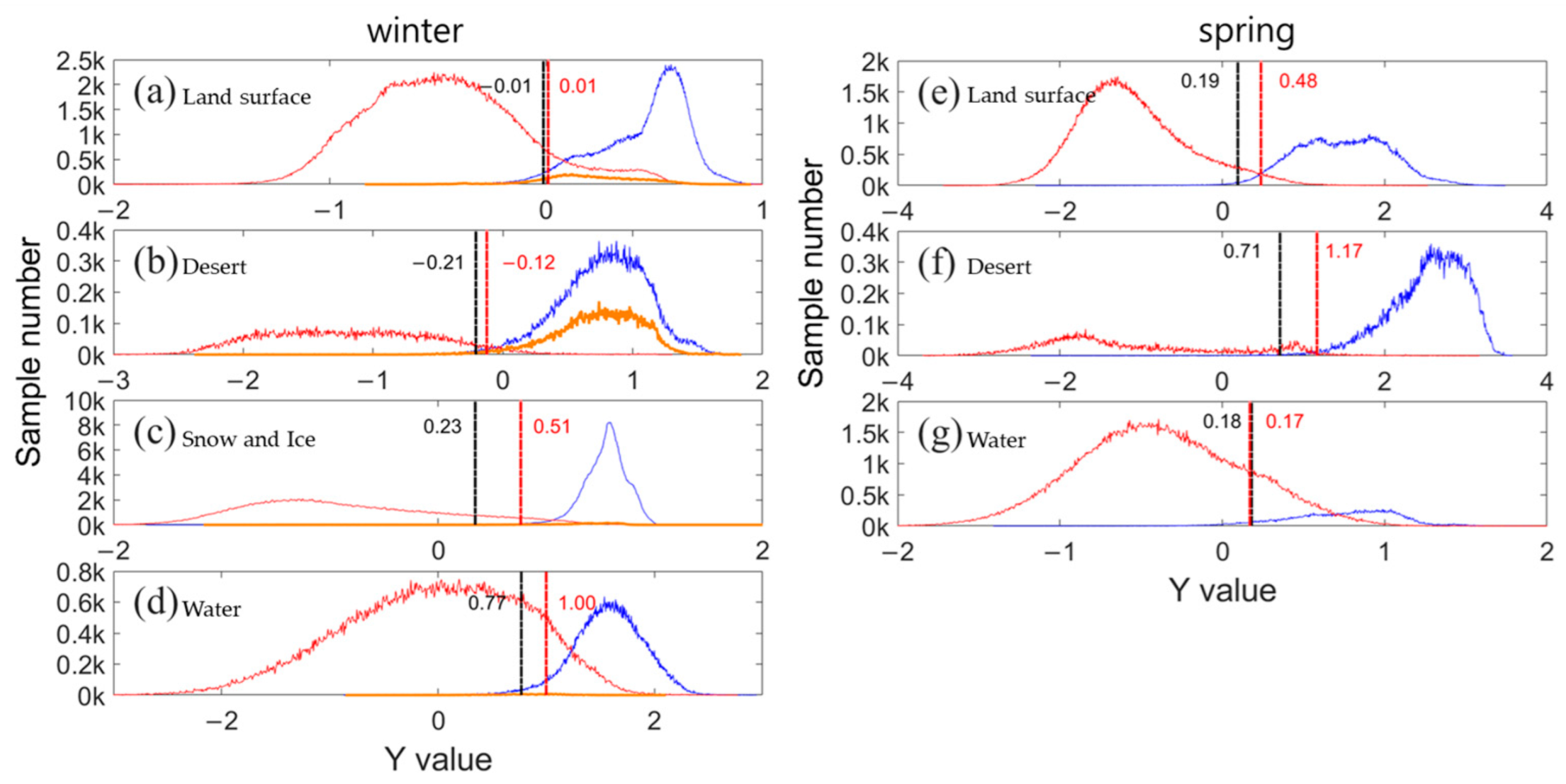

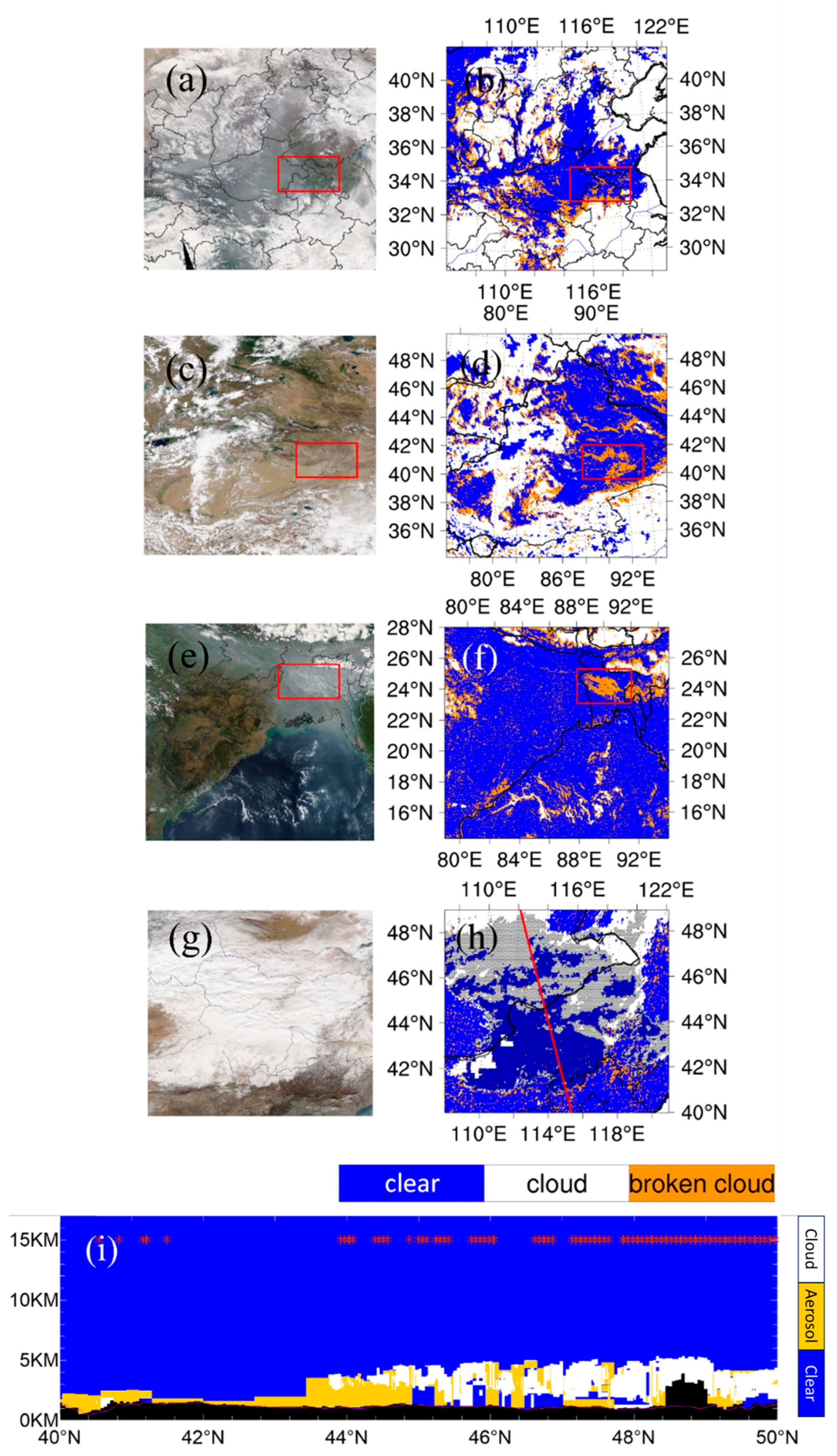
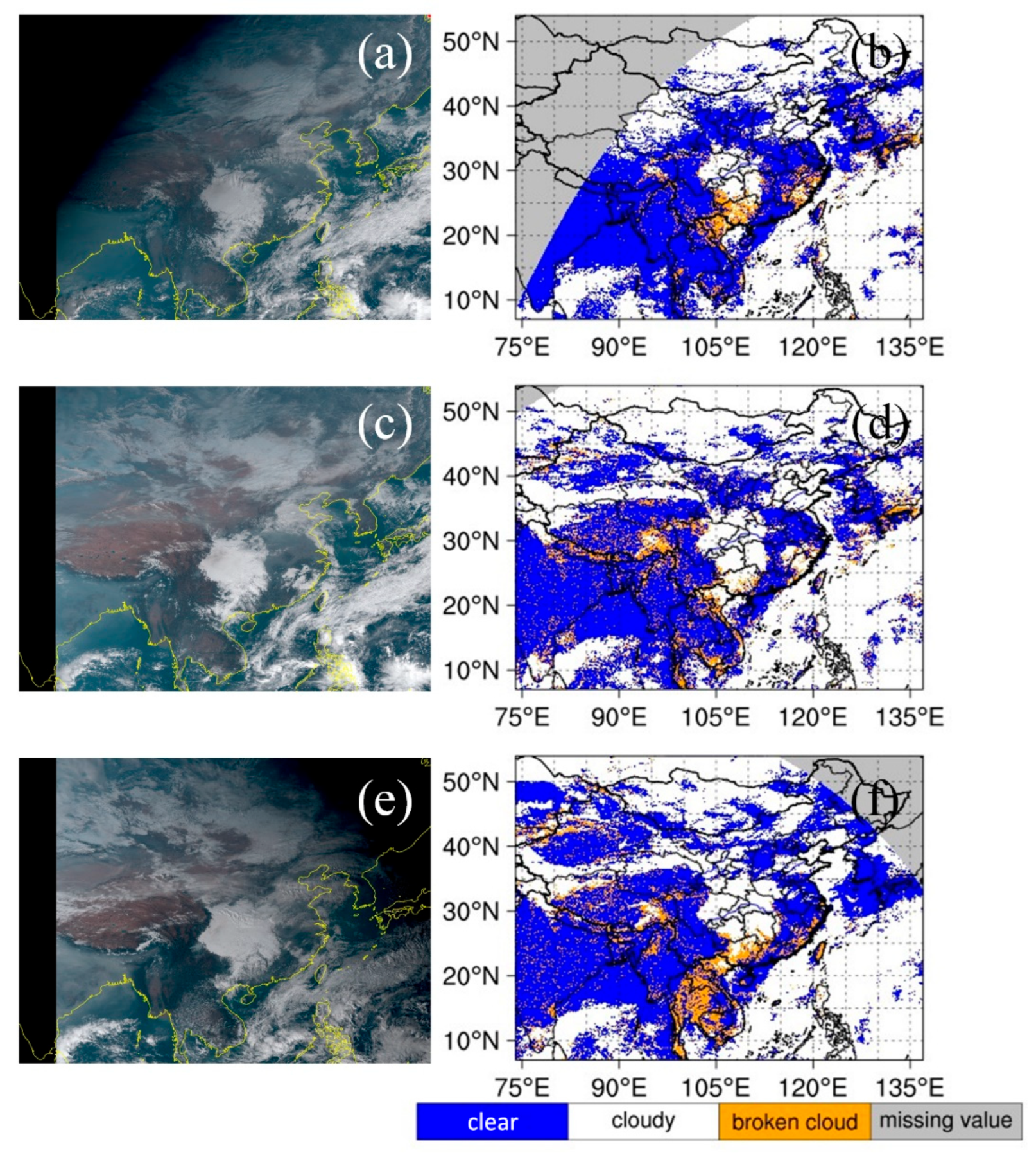
| Land | Desert | Snow/Ice | Water | |
|---|---|---|---|---|
| REF 3 | 1.299814 | −1.08502 | 0.575017 | 2.017792 |
| REF 9 | −2.68352 | 0.146133 | 0.317414 | −0.45535 |
| REF 10 | 3.834834 | 3.898747 | −0.21676 | 3.563714 |
| REF 11 | 45.33824 | −2.78985 | −1.49741 | −1.15359 |
| REF 12 | 23.06156 | 7.064531 | −0.42344 | 7.670586 |
| BT 29 | 18.90707 | 33.7264 | 34.5497 | −0.1916 |
| BT 31 | 163.8991 | 216.9865 | 11.9891 | 144.5935 |
| BT 32 | −135.508 | −209.542 | −48.9078 | −112.187 |
| REF 11–REF 15 | −34.2317 | 4.41591 | 1.45125 | 3.876359 |
| BT 32–BT 24 | −50.4345 | −47.9583 | −6.56382 | −31.1843 |
| Threshold | 3.078048 | 20.54068 | −5.494 | 8.53148 |
| Winter | Summer | ||||||
|---|---|---|---|---|---|---|---|
| Land | Desert | Water | Snow | Land | Desert | Water | |
| 0.47 μm | −0.185 | 0.132 | 0.885 | 0.219 | −1.127 | −0.392 | 1.569 |
| 0.65 μm | −0.078 | −0.760 | −1.316 | 0.344 | 1.182 | 0.268 | −1.573 |
| 0.83 μm | ― | ― | 0.296 | ― | ― | ― | ― |
| 1.37 μm | 0.108 | 0.207 | 0.165 | ― | ― | 0.903 | ― |
| 1.61 μm | −0.140 | −0.276 | −0.069 | −1.518 | −0.634 | 0.126 | ― |
| 2.22 μm | 0.211 | ― | −0.270 | ― | 0.343 | ― | ― |
| 3.72 μm (high) | −0.193 | −0.632 | 0.114 | 0.018 | 1.016 | 0.853 | −0.102 |
| 3.72 μm (low) | −0.041 | 1.164 | −0.292 | −0.599 | 1.309 | −1.798 | −0.542 |
| 6.25 μm | −0.070 | −0.541 | −0.006 | 0.046 | 0.446 | 0.330 | 1.541 |
| 7.10 μm | 0.037 | 0.587 | 0.147 | ― | −0.986 | −0.564 | −2.196 |
| 8.50 μm | −1.032 | −1.452 | −1.803 | −1.663 | −0.432 | 1.717 | −1.602 |
| 10.8 μm | 1.597 | 1.779 | 2.245 | 2.731 | 2.408 | 1.629 | 3.427 |
| 12.0 μm | ― | ― | ― | ― | ― | ― | ― |
| 13.5 μm | ― | ― | ― | ― | ― | ― | ― |
| y0 | 0.010 | −0.124 | 0.510 | 1.000 | 0.477 | 1.166 | 0.170 |
Disclaimer/Publisher’s Note: The statements, opinions and data contained in all publications are solely those of the individual author(s) and contributor(s) and not of MDPI and/or the editor(s). MDPI and/or the editor(s) disclaim responsibility for any injury to people or property resulting from any ideas, methods, instructions or products referred to in the content. |
© 2025 by the authors. Licensee MDPI, Basel, Switzerland. This article is an open access article distributed under the terms and conditions of the Creative Commons Attribution (CC BY) license (https://creativecommons.org/licenses/by/4.0/).
Share and Cite
Zhang, X.; Zhao, S.-Y.; Tang, R.-X. Improved Daytime Cloud Detection Algorithm in FY-4A’s Advanced Geostationary Radiation Imager. Atmosphere 2025, 16, 1105. https://doi.org/10.3390/atmos16091105
Zhang X, Zhao S-Y, Tang R-X. Improved Daytime Cloud Detection Algorithm in FY-4A’s Advanced Geostationary Radiation Imager. Atmosphere. 2025; 16(9):1105. https://doi.org/10.3390/atmos16091105
Chicago/Turabian StyleZhang, Xiao, Song-Ying Zhao, and Rui-Xuan Tang. 2025. "Improved Daytime Cloud Detection Algorithm in FY-4A’s Advanced Geostationary Radiation Imager" Atmosphere 16, no. 9: 1105. https://doi.org/10.3390/atmos16091105
APA StyleZhang, X., Zhao, S.-Y., & Tang, R.-X. (2025). Improved Daytime Cloud Detection Algorithm in FY-4A’s Advanced Geostationary Radiation Imager. Atmosphere, 16(9), 1105. https://doi.org/10.3390/atmos16091105






